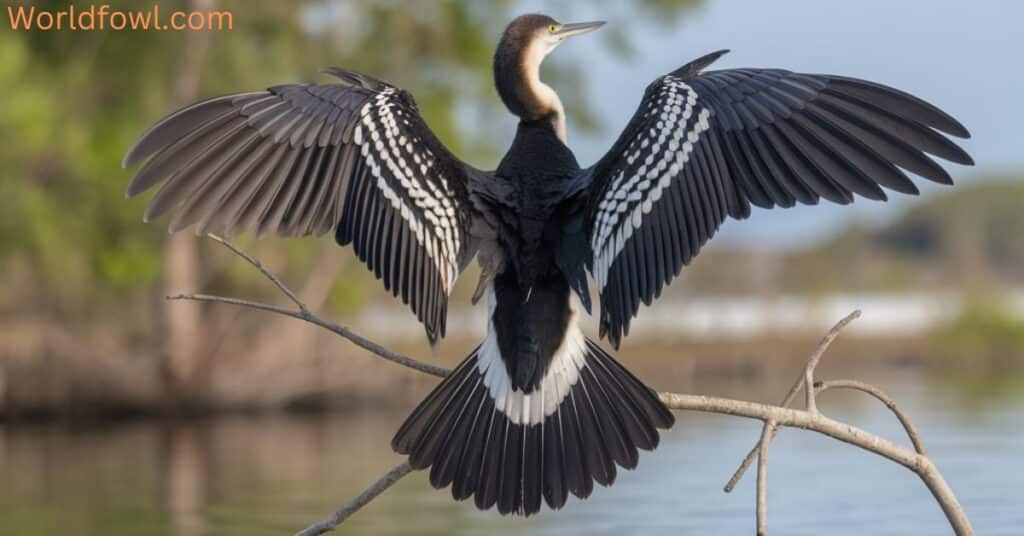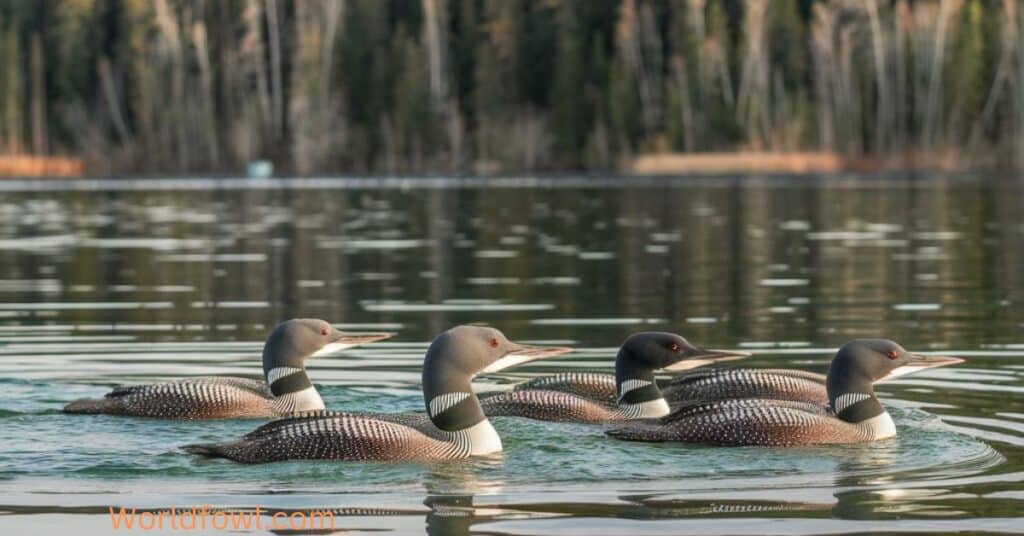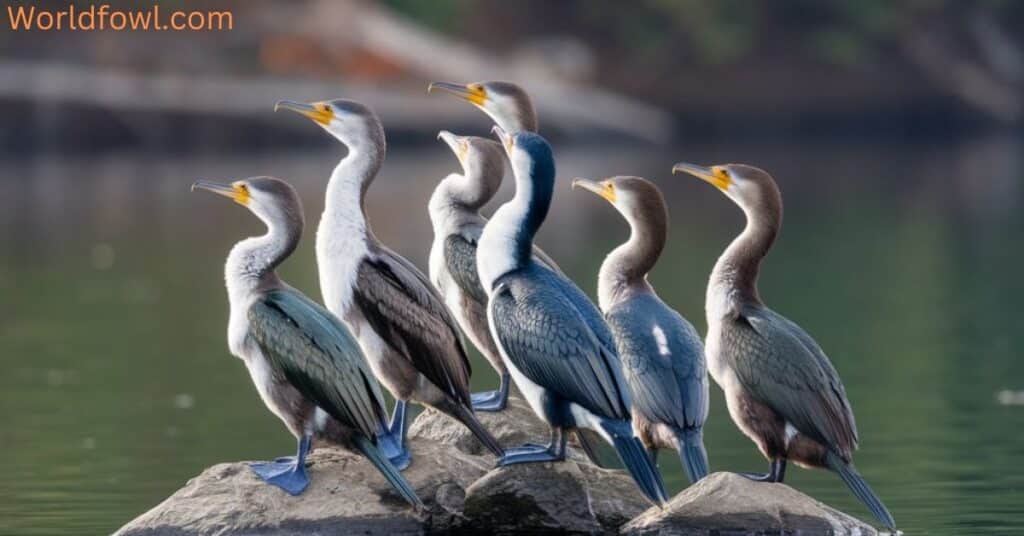In the vast world of aquatic avians, cormorants stand out with their distinctive silhouettes and impressive diving abilities. But they’re not alone in their prowess. Several other bird families have evolved similar traits, creating a group of birds similar to cormorants that can leave even experienced birdwatchers scratching their heads. This fascinating phenomenon of convergent evolution has resulted in a variety of species that, at first glance, might be mistaken for cormorants. Let’s plunge into the world of these aquatic look-alikes and uncover the subtle differences that set them apart from their cormorant cousins.
Understanding Cormorants: The Benchmark for Comparison
Before we dive into the world of birds similar to cormorants, it’s essential to understand what makes cormorants unique. Cormorants are large, fish-eating birds known for their:
- Dark, often iridescent plumage
- Long necks and hooked bills
- Webbed feet for efficient swimming
- Ability to dive deep and swim underwater for extended periods
These characteristics have evolved to make cormorants excellent fishers, perfectly adapted to their aquatic lifestyle. We’ll see how nature has crafted other species with comparable features, resulting in birds that bear a striking resemblance to cormorants despite being from different families.
The Magnificent Five: Cormorant Cousins and Copycats
1. Anhinga: The Snake Bird

Among the birds similar to cormorants, the Anhinga, also known as the snakebird or darter, is perhaps the closest look-alike. These fascinating birds belong to the family Anhingidae and are often found in the same habitats as cormorants.
Key features of the Anhinga that make it one of the birds similar to cormorants:
- Long, snake-like necks that seem to disappear underwater
- Sharply pointed bills to impale fish
- Dark plumage that can appear similar to cormorants when wet
Unlike cormorants, Anhingas have a unique way of drying their wings. They’ll often be seen perched with wings spread wide, creating an unmistakable silhouette against the sky. This behavior is due to their lack of oils in their feathers, which allows them to swim lower in the water but requires them to dry off more frequently.
“The Anhinga moves through the water like a living spear, silent and deadly.” – John James Audubon
Interesting fact: Anhingas can regulate their buoyancy by adjusting the amount of air in their respiratory system, allowing them to sink or float as needed. This adaptation is shared by other birds similar to cormorants, showcasing how different species have evolved similar traits to thrive in aquatic environments.
you may like : Where Do Hummingbirds Go At Night? Hummingbird Night Life Exposed
2. Booby Birds: Divers with a Difference

Boobies, despite their comical name, are impressive large fish-eating birds that share many characteristics with cormorants. They’re part of the Sulidae family, which includes gannets, and are another excellent example of birds similar to cormorants.
Notable booby species:
- Blue-footed Booby
- Red-footed Booby
- Masked Booby
While boobies share the cormorant’s love for fish and are often considered birds similar to cormorants, they have some distinct differences:
| Feature | Boobies | Cormorants |
| Feet | Brightly colored | Usually black |
| Bill | Conical, serrated edges | Hooked at tip |
| Diving style | Plunge from heights | Surface dive |
| Wing shape | Longer, more pointed | Shorter, rounded |
Boobies are known for their spectacular plunge-diving, dropping from heights of up to 100 feet to catch fish. Their adaptations for this hunting style include:
- Air sacs under the skin to cushion the impact
- Nostrils that close underwater
- Eyes positioned to provide binocular vision when diving
These adaptations showcase how birds similar to cormorants have evolved unique features to exploit similar food sources in different ways.
3. Grebes: The Freshwater Phantom

Grebes are another group of birds that might be mistaken for cormorants, especially at a distance. These freshwater divers have some fascinating adaptations that set them apart from other birds similar to cormorants.
Grebe characteristics that make them birds similar to cormorants:
- Sleek, streamlined bodies for efficient swimming
- Ability to dive and swim underwater for long periods
- Dark plumage that can appear similar to cormorants in certain light
However, grebes have several unique features that distinguish them from cormorants and other birds similar to cormorants:
- Lobed feet instead of fully webbed feet
- Small heads and thin necks
- Ability to sink slowly into the water, almost like a submarine
Waterproof plumage is crucial for both grebes and cormorants, but grebes take it a step further. They actually eat their own feathers, which line their stomachs and help protect against sharp fish bones! This unique adaptation is not seen in cormorants or other birds similar to cormorants.
Case study: The Western Grebe’s “rushing” display Western Grebes perform an incredible courtship display where they literally run across the water’s surface side by side. This “rushing” can cover distances of up to 20 meters, showcasing the power in their lobed feet. This spectacular behavior sets them apart from cormorants and other birds similar to cormorants, highlighting the diversity within this group of aquatic birds.
you may also like : Do Geese Fly At Night? How Can They See?
4. Loons: The Northern Divers

When considering cormorant vs loon identification, it’s important to note that loons are primarily found in the northern hemisphere and have some distinct features that make them birds similar to cormorants while maintaining their unique identity.
Loon highlights that make them birds similar to cormorants:
- Excellent diving and swimming abilities
- Fish-based diet
- Dark plumage (in breeding season)
However, loons have several characteristics that set them apart from cormorants and other birds similar to cormorants:
- Heavier build than cormorants
- Dagger-like bills perfect for catching fish prey
- Haunting, yodel-like calls that are iconic to northern lakes
Loons are incredibly efficient swimmers, capable of staying underwater for several minutes while pursuing fish. Their legs are set far back on their bodies, making them excellent divers but awkward on land. This extreme adaptation for aquatic life is even more pronounced in loons than in cormorants and other birds similar to cormorants.
Bold fact: A Common Loon can dive to depths of up to 200 feet, showcasing their incredible diving abilities that rival even those of cormorants!
5. Finfoots: The Elusive River Dwellers

Perhaps the least known of our birds similar to cormorants, finfoot species are rare and elusive birds found in tropical water ecosystems. These birds are so rarely seen that they’re often considered a prized sighting for any birdwatcher.
Finfoot features that make them birds similar to cormorants:
- Aquatic lifestyle
- Ability to swim with only their heads above water
- Fish-based diet
However, finfoots have several unique characteristics that distinguish them from cormorants and other birds similar to cormorants:
- Lobed toes (similar to grebes)
- Long tails used as rudders
- Preference for slow-moving rivers and swamps over open water
There are only three species of finfoot in the world, making them a truly unique group among. Their rarity and elusiveness add an element of mystery to these fascinating birds.
Shags vs. Cormorants: Siblings or Distant Cousins?

The term “shag” often causes confusion among birdwatchers exploring birds similar to cormorants. Are shags just another name for cormorants, or are they distinct? This question highlights the complexity within the group.
Truth is, shags and cormorants are closely related, both belonging to the family Phalacrocoracidae. They’re so similar that they’re often considered birds similar to cormorants even though they are, in fact, types of cormorants themselves. The main differences are:
- Size: Shags tend to be slightly smaller
- Crest: Many shag species have a distinctive crest on their heads
- Habitat: Shags are more strictly marine than some cormorant species
It’s worth noting that in some parts of the world, the terms are used interchangeably, adding to the confusion when discussing birds similar to cormorants. This complexity within the cormorant family itself demonstrates how challenging it can be to distinguish between these aquatic birds.
you also like : Woodpeckers In BC – The Complete Guide To 11 British Columbia Woodpeckers
Convergent Evolution: Nature’s Copy-Paste Function

They’re a result of convergent evolution, where unrelated species develop similar traits due to similar environmental pressures. This fascinating process explains why birds from different families can look so alike at first glance, creating the group we refer to as birds similar to cormorants.
Examples of shared adaptations among them :
- Waterproof feathers for efficient swimming
- Long, slim bills for catching fish
- Powerful legs and feet for underwater propulsion
- Dark plumage that often appears glossy or iridescent
Despite their different evolutionary histories, they’ve all converged on similar solutions to the challenges of an aquatic lifestyle.
Birdwatcher’s Corner: Tips and Tricks
Distinguishing between these birds similar to cormorants can be challenging, even for experienced birdwatchers. Here are some tips to help you tell these look-alikes apart:
- Observe behavior:
- Cormorants often spread their wings to dry
- Anhingas frequently swim with just their long necks above water
- Boobies plunge-dive from great heights
- Loons and grebes rarely spread their wings to dry
- Check the bill:
- Cormorants have hooked bills
- Anhingas have straight, dagger-like bills
- Boobies have conical bills with serrated edges
- Loons and grebes have straight, dagger-like bills
- Watch the dive:
- Boobies plunge from height
- Cormorants and other birds similar to cormorants typically surface dive
- Listen:
- Loons have distinctive, haunting calls
- Cormorants and most other birds similar to cormorants are relatively quiet
- Look at the feet:
- Cormorants and boobies have fully webbed feet
- Grebes and finfoots have lobed toes
Best locations for spotting:
- Cormorants: Coastal areas and large inland water bodies
- Anhingas: Freshwater swamps in the southeastern United States
- Boobies: Tropical and subtropical coastlines
- Grebes: Freshwater lakes across North America and Eurasia
- Loons: Northern lakes in summer, coastal areas in winter
- Finfoots: Tropical rivers in South America, Africa, and Asia
By paying attention to these details, you’ll become more adept at distinguishing between cormorants and other birds similar to cormorants, enhancing your birdwatching experience.
you may also like : 11 Types of Owls In Ontario (With Photos)
Conservation Spotlight: Protecting Birds Similar to Cormorants

Many of these fish-eating birds, including cormorants and birds similar to cormorants, face similar threats in their aquatic habitats. Understanding these challenges is crucial for conservation efforts:
- Habitat loss due to coastal development
- Water pollution affecting their prey
- Entanglement in fishing gear
- Climate change altering their habitats and food sources
These threats affect not only cormorants but all birds similar to cormorants, highlighting the interconnectedness of aquatic ecosystems and the need for comprehensive conservation strategies.
Success story: Double-crested Cormorant comeback After facing near-extinction due to DDT contamination in the mid-20th century, Double-crested Cormorant populations have rebounded significantly thanks to conservation efforts and the banning of DDT.
How you can help protect birds similar to cormorants:
- Support wetland conservation efforts
- Reduce plastic use to prevent marine pollution
- Participate in citizen science projects monitoring water bird populations
- Advocate for sustainable fishing practices
The Cultural Significance of Birds Similar to Cormorants
Throughout history, cormorants and birds similar to cormorants have played significant roles in various cultures around the world. These birds have inspired art, literature, and even certain fishing practices.
In China and Japan, fishermen have traditionally used trained cormorants to catch fish, a practice known as cormorant fishing. While this isn’t typically done with other birds similar to cormorants, it highlights the unique relationship between humans and these aquatic birds.
In many Native American cultures, loons (one of the birds similar to cormorants we’ve discussed) are considered sacred birds, often associated with spiritual guidance and foresight. Their haunting calls are woven into numerous legends and stories.
Even in modern times, birds similar to cormorants continue to capture our imagination. The blue-footed booby, with its distinctive feet, has become an iconic symbol of the Galápagos Islands, drawing tourists from around the world.
These cultural connections underscore the importance of conserving not just cormorants, but all birds similar to cormorants, as they are an integral part of our natural and cultural heritage.
The Future of Research on Birds Similar to Cormorants
As our understanding of avian biology and ecology grows, so does our knowledge. Current and future research areas include:
- Climate change impacts: How will changing temperatures and water levels affect the habitats.
- Pollution effects: What are the long-term impacts of microplastics and other pollutants on these birds and their prey?
- Migration patterns: How are the migration routes of birds similar to cormorants changing in response to environmental shifts?
- Interspecies competition: How do cormorants and other birds similar to cormorants interact and compete in shared habitats?
- Conservation genetics: Can genetic studies help us better protect vulnerable populations of these birds?
This ongoing research is crucial for the conservation. The ecosystems they inhabit. By continuing to study these fascinating birds, we can develop more effective strategies to protect them and their aquatic homes.
Conclusion: The Joy of Look-Alike Challenges
From the snake-like Anhinga to the elusive finfoot, each species has its own unique adaptations that make it perfectly suited to its aquatic lifestyle.
Next time you’re near water, take a closer look at those dark feathers slicing through the waves. Is it a cormorant, or one of its fascinating look-alikes? The challenge of identifying these birds similar to cormorants is part of what makes birdwatching such a rewarding hobby.
Remember, whether it’s a cormorant, loon, grebe, or any other water bird, each plays a crucial role in its ecosystem. By understanding and appreciating these birds similar to cormorants, we can better protect the diverse aquatic habitats they call home.
As we’ve seen, the term “birds similar to cormorants” encompasses a diverse group of species, each with its own unique characteristics and adaptations. While they may share similarities in appearance and lifestyle, each bird – be it an anhinga, booby, grebe, loon, or finfoot – has its own special place in the tapestry of aquatic ecosystems.
By learning to distinguish between these birds similar to cormorants, we not only enhance our birdwatching skills but also gain a deeper appreciation for the intricate ways in which evolution has shaped these remarkable creatures. So next time you spot a cormorant-like bird, take a moment to observe its unique features and behaviors. You might just discover a newfound appreciation for the wonderful world.
Additional Resources
To further your knowledge about these fascinating fish-eating birds and birds similar to cormorants, consider these resources:
- Field Guides:
- “The Sibley Guide to Birds” by David Allen Sibley
- “National Geographic Field Guide to the Birds of North America”
- “Waterbirds of the World” by James Hancock
- Mobile Apps:
- Merlin Bird ID (Cornell Lab of Ornithology)
- Audubon Bird Guide App
- Citizen Science Projects:
- eBird (global bird observation platform)
- Christmas Bird Count (annual census of birds in the Western Hemisphere)
- Project FeederWatch (focuses on backyard birds, but includes some aquatic species)
- Organizations:
- Audubon Society
- BirdLife International
- Wetlands International
- Waterbird Society
- Scientific Journals:
- Waterbirds: The International Journal of Waterbird Biology
- Marine Ornithology
- Journal of Field Ornithology
- Online Courses:
- “Ornithology: Comprehensive Bird Biology” by Cornell Lab of Ornithology
- “Marine and Aquatic Ornithology” by various universities on platforms like Coursera
These materials can help you refine your identification skills, understand the ecological roles of these birds, and contribute to their conservation.

Henry James is a seasoned blogger and a passionate storyteller on “World Fowl.” With years of experience crafting engaging content, he brings a unique blend of expertise and creativity to his writing. Henry specializes in exploring diverse topics with depth and clarity, captivating readers worldwide.







